
WordPress 5.2 “Jaco” was officially released on May 7, 2019, maybe now you need WordPress hosting recommendation that supports WordPress 5.2. In this article, we will give you our best and cheap WordPress 5.2 hosting.
This version comes packed with a lot of exciting changes, the biggest one being the new Site Health check tool which will help both educate users and give developers the essential information they need. Other improvements include PHP error protection (fewer white screens of death), block editor improvements, new dashicons and emojis, and various developer and accessibility updates.
As the WordPress team describes it:
WordPress 5.2 gives you even more robust tools for identifying and fixing configuration issues and fatal errors. Whether you are a developer helping clients or you manage your site solo, these tools can help get you the right information when you need it.
This is the second major release since the launch of the WordPress block editor (AKA Gutenberg) in WordPress 5.0. Below we’ll dive into all the new improvements and the most important changes you will find with this latest WordPress release.
Site Health Check
We saw the first site health check features back in WordPress 5.1 when they added PHP version compatibility checks for plugins and themes. In WordPress 5.2, they’ve added a completely new tool which comes with two new pages to help debug common issues due to server and software configurations, PHP versions, etc.
Site Health Status
Under “Tools” → “Site Health” there is a new page called “Status.” The site health check shows critical information about your WordPress configuration and items that require your attention.
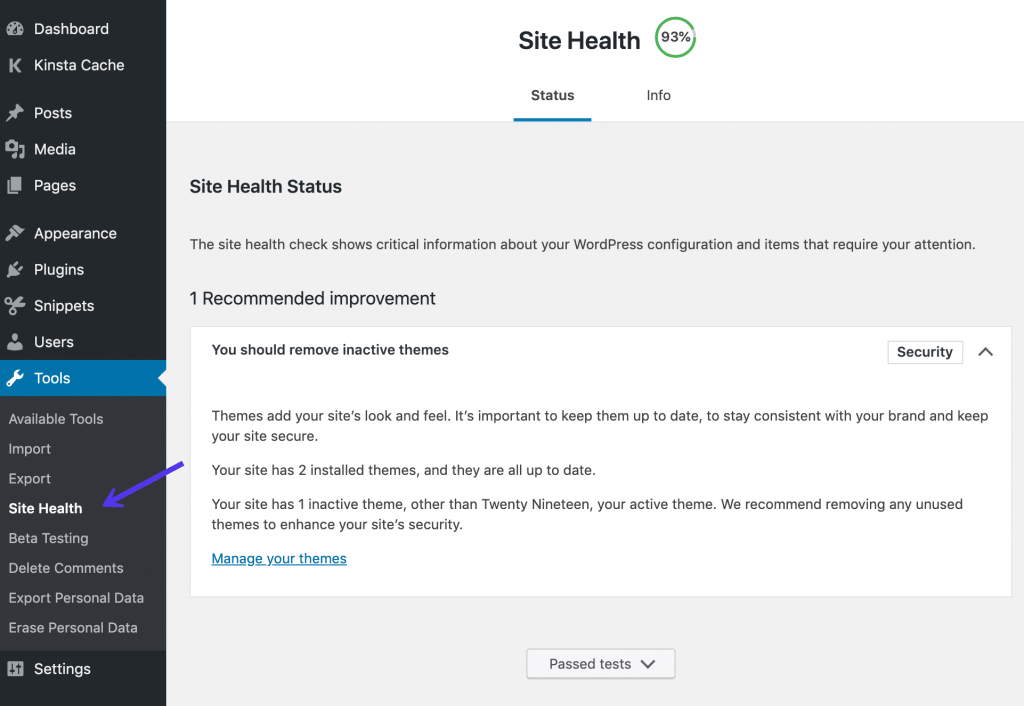
One thing you’ll probably notice right away is that they’ve added a percentage score grade at the top of the page based on how many tests your site passes. Some aren’t happy about this and there is a discussion among developers of whether or not a grading system should exist. The main reason is that scores sometimes create additional problems as users are obsessed with scoring 100%.
However, we are glad to see this, as it will help raise awareness among users. For example, a check for inactive plugins and themes is important. Why?
Many don’t realize that simply because something isn’t active on your WordPress site doesn’t mean someone can’t execute the code if they browse directly to it. Therefore, in order to keep your WordPress site secure, it’s recommended to completely remove inactive themes and plugins if they aren’t being used.
The tests in the new Site Health tool includes checks for the following performance and security-related items:
Performance Checks ?
- Latest WordPress version
- Up to date version of PHP
- Up to date SQL server
- Required and recommended PHP modules are installed
- UTF8MB4 is supported
- Scheduled events
- Working HTTP requests
- REST API available
- Can perform loopback requests
Security Checks ?
- Only running active themes
- Up to date plugins
- HTTPs connection
- Secure communication
- Debug mode off
- Can communicate with WordPress.org
- Background updates are working
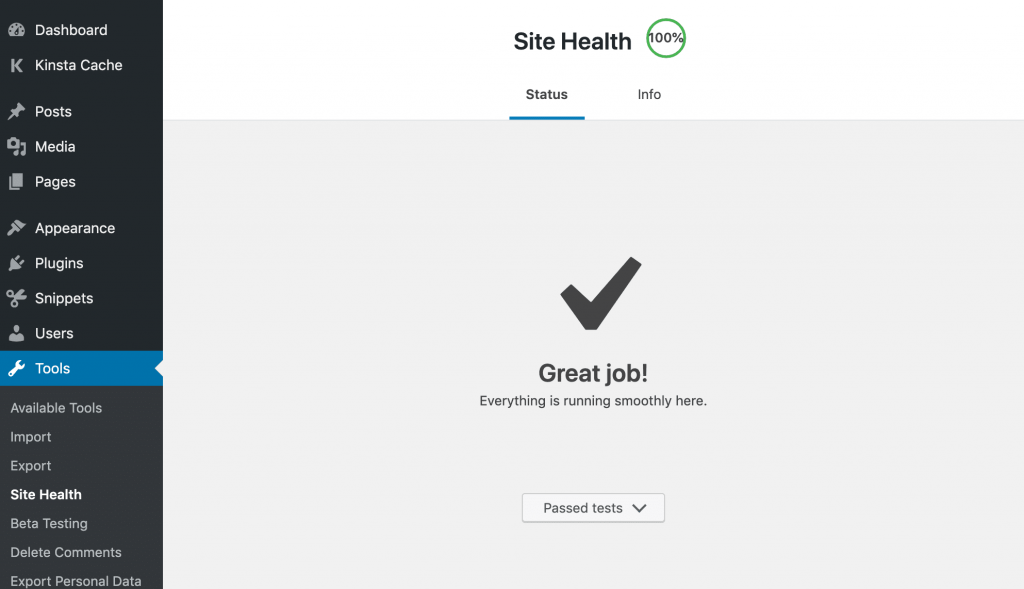
The tests are also filterable via site_status_tests, meaning plugin or theme developers can add their own tests, or remove existing ones.
Site Health Info
Under “Tools” → “Site Health” there is another new page called “Info.” This is a place to find helpful debugging information about your WordPress site’s configuration which you can share with developers, hosting providers, etc. There is a handy “Copy site info to clipboard” button which allows you to easily grab the information and paste it into a text file to share with a third-party.
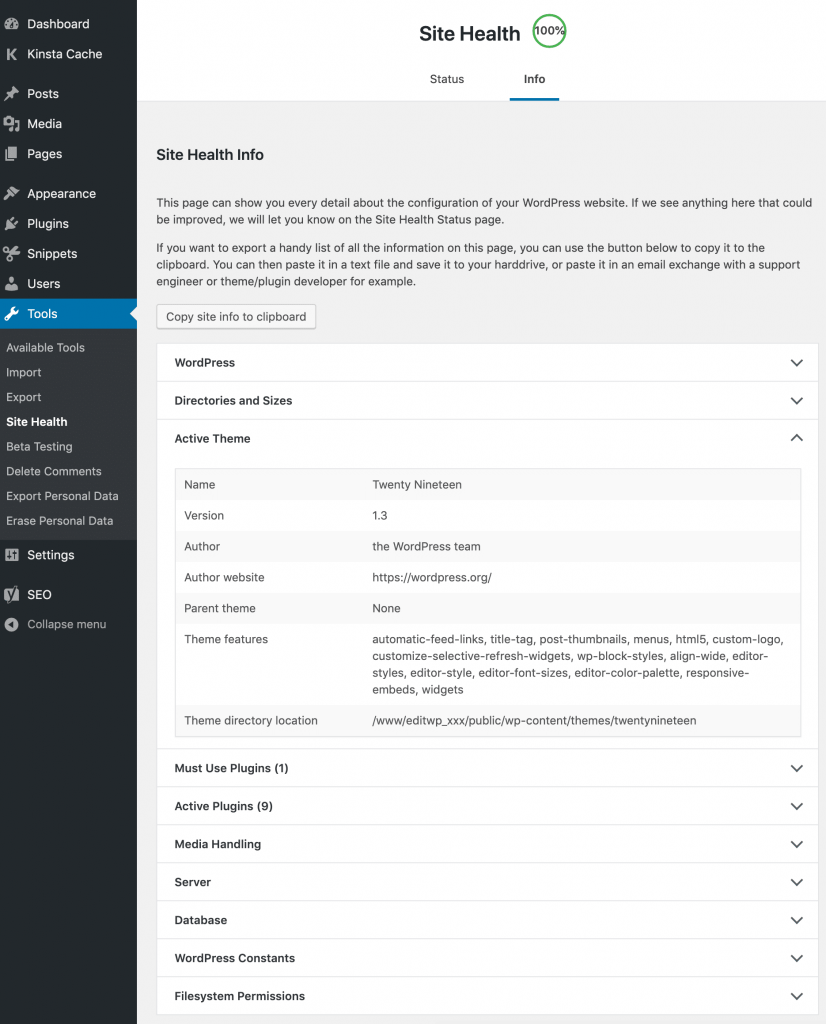
The Site Health Info page contains hundreds of different data points about your WordPress site. Without a doubt, this new page will help developers get the information they need from users faster.
Here’s just a small snapshot of some of the awesome and very helpful details you can quickly see.
- WordPress: WordPress version, site language, user language, Home URL and Site URL, permalink structure, multisite check, number of users.
- Directories and Sizes: WordPress directory location, size, upload location and size, theme location and size, plugin location and size, database size, total installation size.
- Active Theme: Name of theme, version, author, author website, parent theme, theme features, theme directory location.
- Must Use Plugins: Details of any must use plugins currently running, version numbers, and author names.
- Active Plugins: Active plugins running, version numbers, and author names.
- Media Handling: Active editor, ImageMagick version number, string, resource limits, GD version, Ghostscript version.
- Server: Server architecture (such as Linux, Windows, etc.), Web server (such as Nginx or Apache), PHP version, PHP SAPI, PHP max input variables, time limit, memory limit, max input time, upload max filesize, post max size, cURL version, SUHOSIN status, Imagick library status, .htaccess rules.
- Database: Extension, server version, client version, database user, host, name, prefix.
- WordPress Constants: ABSPATH, WP_HOME, WP_SITEURL, WP_CONTENT_DIR, WP_PLUGIN_DIR, WP_MAX_MEMORY_LIMIT, WP_DEBUG, WP_DEBUG_DISPLAY, WP_DEBUG_LOG, SCRIPT_DEBUG, WP_CACHE, CONCATENATE_SCRIPTS, COMPRESS_SCRIPTS, COMPRESS_CSS, WP_LOCAL_DEV.
- Filesystem Permissions: Check against the following directories to see if they are writable. Main WordPress directory, wp-content directory, uploads directory, plugins directory, themes directory, must use plugins directory.
WordPress 5.2’s new Site Health tool provides amazing debugging info for developers to better help users!
PHP Error Protection
WordPress 5.1 was originally scheduled to introduce a new feature called “fatal error protection” which would protect from the WordPress white screen of death while updating PHP. However, due to several critical flaws, this feature was delayed. It has now been included in WordPress 5.2.
With this protection, WordPress will recognize when a fatal error occurs and pause the offending theme or plugin in the WordPress admin dashboard so that you’ll still be able to log into the backend of your site and (hopefully) fix the problem. For less tech-savvy users, this is a great new feature. All we can say is, we wish this feature had been added years ago!
However, we always still recommend using a staging environment when testing out a new version of PHP.
If your site experiences issues while upgrading PHP versions, it will look like the image below on the front-end, but you will still be able to log into the backend to fix the problem.
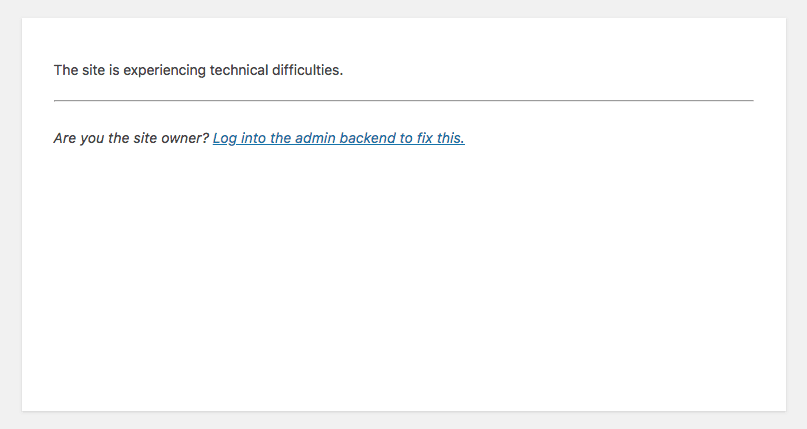
On the backend, you will see a message letting you know that your WordPress site is currently in recovery mode and that there may be an error with a theme or plugin.

Miscellaneous Developer Updates
WordPress 5.2 also comes with improvements for developers; everything from improvements to the block editor and privacy policy pages, a new WordPress hook, updates to the coding standard, and more.
Block Editor Improvements
There were dozens of improvements made to the block editor (Gutenberg) that is shipping with WordPress 5.2. A few that caught our eye:
- In 5.0,
WP_Screen::is_block_editor()was introduced to allow developers to conditionally execute code depending on whether the block editor is being loaded. However, there were some issues with this that have now been fixed in WordPress 5.2. - Media and text blocks got enhanced.
- Image and block resizers are much better than before.
- There were performance improvements made in terms of loading time.
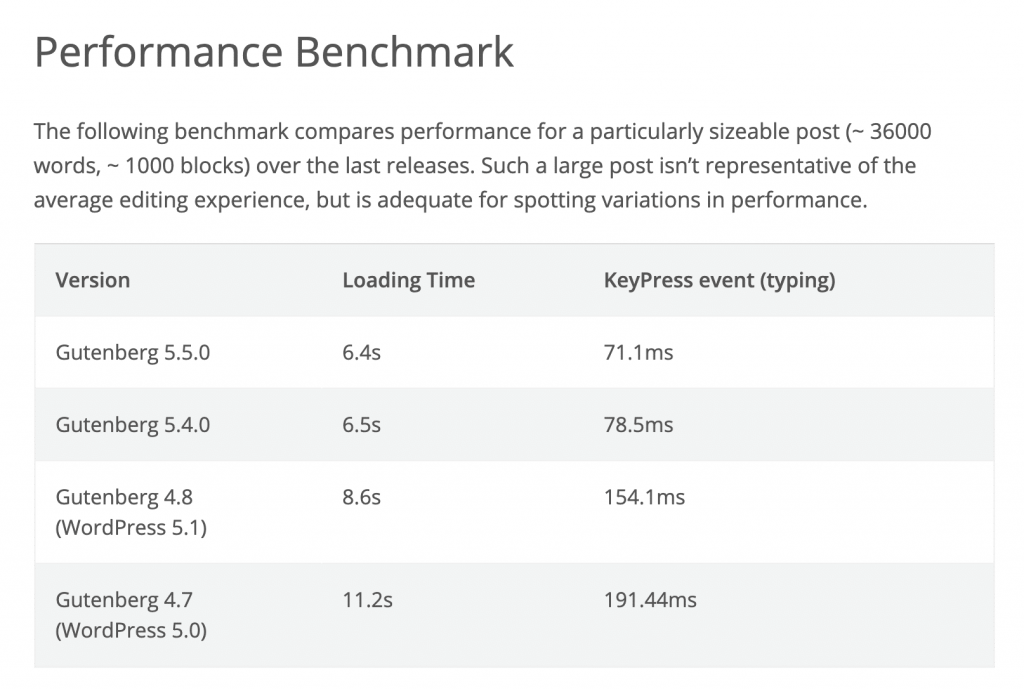
PHP Coding Standard Updates
WordPress now officially recommends running PHP 5.6 or higher with your hosting provider.
With WordPress 5.2, this means developers can take advantage of new coding standards such as namespaces, anonymous functions, short array syntax, short ternary syntax, and assignments with conditionals. If you’re a developer and have already been running on PHP 7 or higher for a while now, this might not impact you, but it’s good to see WordPress making updates.
Privacy Updates
WordPress 5.2 brings several improvements for developers working with Privacy Policy pages and data exports.
The first is four new helpers which will make customizing the privacy policy page easier:
- New function:
is_privacy_policy() - A new theme template file:
privacy-policy.php - New body class:
.privacy-policy - New menu item class:
.menu-item-privacy-policy
The second change is in regards to data exports:
User Data exports no longer use a hardcoded list, but now use the default list of allowed tags in wp_kses(). New filtering is now available as well.
Improvements for Writing JavaScript
With the addition of webpack and Babel configurations in the @wordpress/scripts package, developers won’t have to worry about setting up complex build tools to write modern JavaScript. Read more about JavaScript improvements.
New Body Tag Hook
WordPress 5.2 adds a new wp_body_open() hook, which lets themes support injecting code right at the beginning of the <body> element. The WordPress team encourages theme developers to start using this.
New Emojis and Dashicons
In terms of visual updates, WordPress 5.2 has new emojis and dashicons.
Twemoji Updated
In WordPress 5.2 the latest version of Twemoji, 12.0.1, was added. Version 12 includes 230 new emojis, including accessibility emojis and our personal favorite, the Sloth.

New Dashicons
Dashicons are used to prettify your WordPress admin dashboard. It was definitely time for an update as they haven’t changed since WordPress 4.5. WordPress 5.2 has 13 new icons, including Instagram, a suite of icons for BuddyPress, and rotated Earth icons for global inclusion. WOFF 2.0 font file format has also been added.
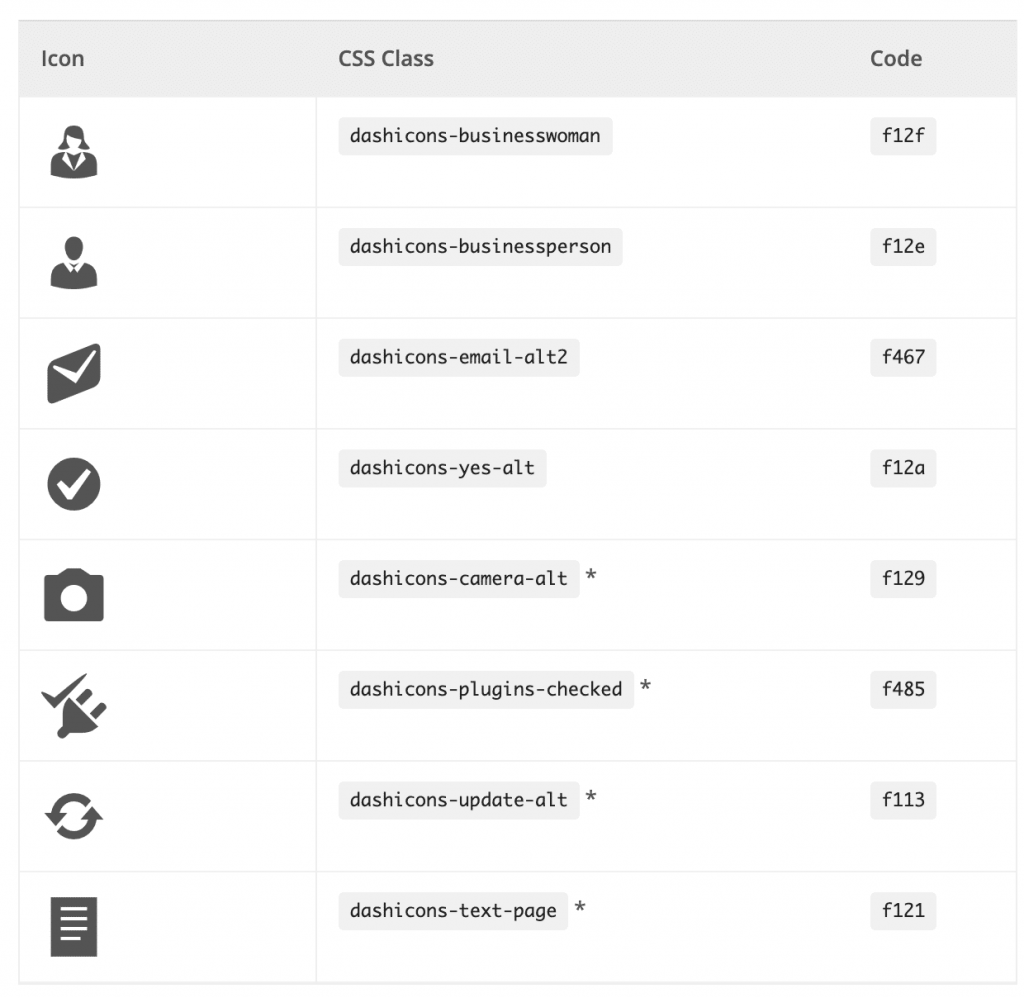
Notable Accessibility Changes
Along with WordPress 5.2 comes a number of changes working together to improve contextual awareness and keyboard navigation flow for those using screen readers and other assistive technologies.
- Post formats are now in list tables.
- New link markup on the WordPress admin bar submenu.
- The currently viewed archive in the archive dropdown widget is now pre-selected.
- A new media view was added to the media library.
- Headings were added to the data tables on the Export Personal Data and Erase Personal Data pages.
- The alt text field is now the first field displayed in the media modal.
Are you looking for Cheap WordPress 5.2 Hosting? Finding a high quality Cheap WordPress 5.2 Hosting provider is crucial for your web application. Your WordPress 5.2 application can only run smooth if it will be hosted on a server which can provide a higher up time & plenty of computing resources. There’re thousands of web hosting providers which offer asp.net hosting, but choosing Cheap WordPress 5.2 Hosting provider is a time consuming task. To make your buying decision easy we’ve concluded 3 Best yet Cheap WordPress 5.2 Hosting providers which are reliable and offer affordable WordPress 5.2 Hosting so that every one can afford it.
Cheap and Reliable WordPress 5.2 Hosting
|
|
|
|
|---|---|---|
| ASPHostPortal | DiscountService.biz | UKWindowsHostASP.NET |
| $1.00/month | $2.00/month | £3.00/month |
| Host 1 Site | Host 1 Site | Host 5 Sites |
| 1 GB Disk Space | 1 GB Disk Space | 1 GB Disk Space |
| 10 GB Bandwidth | 10 GB Bandwidth | 20 GB Bandwidth |
| Dedicated Application Pool | Dedicated Application Pool | Dedicated Application Pool |
| Support UTF-8 Domains | Support UTF-8 Domains | Support UTF-8 Domains |
| 30-Days Money Back | 30-Days Money Back | 30-Days Money Back |
| Latest ASP.NET | Latest ASP.NET | Latest ASP.NET |
| Plesk Control Panel | Plesk Control Panel | Plesk Control Panel |
| Windows 2008/2012 | Windows 2008/2012 | Windows 2008/2012 |
| SQL Server 2008/2012/2014 | SQL Server 2008/2012/2014 | SQL Server 2008/2012/2014 |
| Latest MySql version | Latest MySql version | Latest MySql version |
How to Choose Cheap and Reliable WordPress 5.2 Hosting?
Reliability and Speed of Access
Not only should the web host be reliable and fast, it should guarantee its uptime (the time when it is functional). Look for a minimum uptime of 99%. In fact, even 99% is actually too low — it really should be 99.5% or higher. The host should provide some sort of refund (eg prorated refund or discount) if it falls below that figure. Note though that guarantees are often hard to enforce from your end — especially if the host denies there was any downtime. However, without that guarantee, the web host will have little incentive to ensure that its servers are running all the time.
Data Transfer (Traffic/Bandwidth)
Data transfer (sometimes loosely referred to as “traffic” or “bandwidth”) is the amount of bytes transferred from your site to visitors when they browse your site.
Don’t believe any commercial web host that advertises “unlimited bandwidth”. The host has to pay for the bandwidth, and if you consume a lot of it, they will not silently bear your costs. Many high bandwidth websites have found this out the hard way when they suddenly receive an exorbitant bill for having “exceeded” the “unlimited bandwidth”. Always look for details on how much traffic the package allows. I personally always stay clear of any host that advertises “unlimited transfer”, even if the exact amount is specified somewhere else (sometimes buried in their policy statements). Usually you will find that they redefine “unlimited” to be limited in some way.
In addition, while bandwidth provided is something you should always check, do not be unduly swayed by promises of incredibly huge amounts of bandwidth. Chances are that your website will never be able to use that amount because it will hit other limits, namely resource limits.
To give you a rough idea of the typical traffic requirements of a website, most new sites that don’t provide video or music on their site use less than 3 GB of bandwidth per month. Your traffic requirements will grow over time, as your site becomes more well-known, so you will need to also check their policy when you exceed your data transfer limit: is there a published charge per GB over the allowed bandwidth? Is the charge made according to actual usage or are you expected to pre-pay for a potential overage? It is better not to go for hosts that expect you to prepay for overages, since it is very hard to forsee when your site will exceed its bandwidth and by how much.
Disk space
For the same reason as bandwidth, watch out also for those “unlimited disk space” schemes. Many new sites (that don’t host videos or music) need less than 20 MB of web space, so even if you are provided with a host that tempts you with 100 GB (or “unlimited space”), be aware that you are unlikely to use that space, so don’t let the 100 GB space be too big a factor in your consideration when comparing with other web hosts. The hosting company is also aware of that, which is why they feel free to offer you that as a means of enticing you to host there.
Technical support
Does its technical support function 24 hours a day, 7 days a week (often abbreviated 24/7), all year around? Note that I will not accept a host which does not have staff working on weekends or public holidays. You will be surprised at how often things go wrong at the most inconvenient of times. Incidentally, just because a host advertises that it has 24/7 support does not necessarily mean that it really has that kind of support. Test them out by emailing at midnight and on Saturday nights, Sunday mornings, etc. Check out how long they take to respond. Besides speed of responses, check to see if they are technically competent. You wouldn’t want to sign up with a host that is run by a bunch of salesmen who only know how to sell and not fix problems.
Email, Autoresponders, POP3, Mail Forwarding
If you have your own site, you will probably want to have email addresses at your own domain, like sales@yourdomain.com, etc. Does the host allow you to set up whatever email addresses you want on your domain, so that mail can be forwarded to your current email address, or placed into a mail box on your web hosting account itself? Can you set an email address to automatically reply to the sender with a preset message (called an autoresponder)? Can you retrieve your mail with your email software?
Control Panel
This is called various names by different hosts, but essentially, they all allow you to manage different aspects of your web account yourself. Typically, and at the very minimum, it should allow you to do things like add, delete, and manage your email addresses, and change passwords for your account. I will not sign up with a host where I have to go through their technical support each time I want to change a password or add/delete an email account. Such tasks are common maintenance chores that every webmaster performs time and time again, and it would be a great hassle if you had to wait for their technical support to make the changes for you.
Web Server and Operating System
Is the type of operating system and server important?
In general, most people will want to sign up for a web host offering a Unix-based system (like Linux, FreeBSD or OpenBSD) and running the Apache web server. Most web-based software assume your website is running on such a system, and you will usually experience fewer compatibility issues with it. There are also a lot of guides available on the Internet on configuring such systems, so finding help when you need it is easier as well.
In my opinion, the only time when you will want to use a Windows server is if you’re running Windows-specific programs, like ASP scripts. But even then, you’ll probably be better off looking for a PHP-equivalent, and using a Unix-based system.
Price
I was actually hesitant to list this, but I guess it’s futile not to. However, I would caution that while price is always a factor, you should realise (“realize” in US English) that you often get what you pay for, although it’s not necessarily true that the most expensive hosts are the best.
Monthly/Quarterly/Annual Payment Plans
Most web hosts allow you to select an annual payment plan that gives you a cheaper rate than if you were to pay monthly. My current personal preference is to pay monthly with all new web hosts until I’m assured of their reliability and honesty. Paying monthly allows me to switch web hosts quickly when I find that the current host does not meet my requirements: this way, I’m not tied down to a bad web host because I have prepaid for an entire year. I do this even if the new web host guarantees that they will refund the balance if I’m dissatisfied, since at the point I sign up, I have no assurance that they will honour their guarantee. Later (usually after a couple of years), when I’m satisfied with the host, I may change payment plans to the discounted annual plans.
Resellers?
Not all hosting companies own or lease their own web servers. Some of them are actually resellers for some other hosting company. The disadvantage of using a reseller is the possibility that you are dealing with people who don’t know much about the system they are selling and who take longer to help you (they have to transmit your technical support request to the actual hosting company for it to be acted upon). However, this also depends on both the reseller and the underlying hosting company. It is thus wise not to rule out all resellers; there are a number of reliable and fast ones who are actually quite good and cheap. In fact, a number of resellers sell the same packages cheaper than their original hosting company. If you find out that a particular company is a reseller, you will need to investigate both the reseller and the real hosting company.
International
If you don’t stay in the USA, you have the option of hosting your site with some local provider. The advantage here is the ease of dealing with them (they are after all easily accessible by phone call or a visit), your familiarity with the local laws and easy recourse to those laws should it be necessary. It should be your choice if your target audience is local (eg a local fast food delivery service). On the other hand, hosting it in USA has the advantage of faster access for what is probably the largest number of your overseas visitors (particularly if you have an English-speaking audience). You also have a large number of hosting companies to choose from, and as a result, cheaper prices too.








